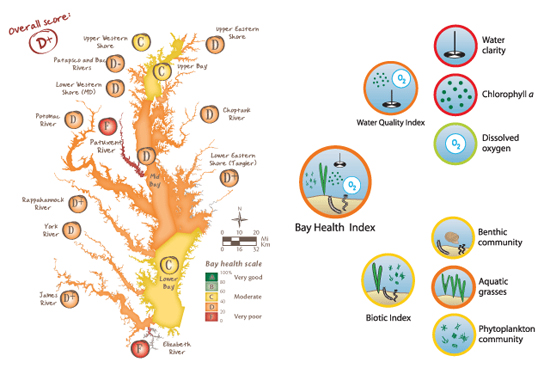Chesapeake Bay health receives D+ on 2011 report card
Unusual weather, including a wet spring, a hot summer and two tropical storms, caused the Bay’s health to decline.
An unusual sequence of weather events, including a wet spring, a hot, dry summer, and two tropical storms, caused the Chesapeake Bay’s health to decline in 2011, according to the University of Maryland Center for Environmental Science (UMCES) and the National Oceanic and Atmospheric Administration (NOAA).

(Image courtesy Chesapeake EcoCheck)
Scientists gave the Bay a D+ on the latest Chesapeake Bay Report Card, an annual assessment of the health of the Bay and its tidal rivers. The score of 38 percent was the second lowest since assessments began in 1986 and down from a C- in 2010.
Only two areas – the lower western shore and the Patapsco and Back rivers – improved last year. The rest of the Bay’s segments remained the same or got worse. Scientists recorded lower scores in the Patuxent River, Rappahannock River, James River, Tangier Sound, and the upper and middle Bay.
"The spring rains and hot, dry summer followed by Tropical Storm Lee and Hurricane Lee led to poor health throughout Chesapeake Bay and its tributaries," said Dr. Bill Dennison of the University of Maryland Center for Environmental Science. "While we have been making considerable progress in various restoration activities, these results indicate we still need to do much more to reduce the input of nutrients and sediments from stormwater runoff into the Bay."
The Bay’s health is largely affected by weather conditions. Rainfall carries pollution from farms, cities and suburbs to storm drains, streams and eventually the Bay. Even as the government, communities and citizens work to reduce pollution, an increase in stormwater runoff can mask the effects of these improvements.
Wet weather last spring washed more nutrient pollution into the water, fueling the growth of algae blooms that blocked sunlight from reaching bay grasses. Hot, dry weather allowed these algae blooms to persist through summer, leading to low-oxygen “dead zones” in the Bay’s bottom waters. In late summer, the Bay was slammed by the effects of Hurricane Irene and Tropical Storm Lee, both of which worsened water clarity.
"The report card clearly indicates that the Chesapeake Bay watershed is a dynamic ecosystem subject to severe weather events," said Bay Program Director Nick DiPasquale. “The silver lining is that the Hopkins-UMCES study of 60 years of water quality data concluded that a decrease in the frequency and severity of dead zones in the Bay is the direct result of implementing measures to reduce nitrogen and phosphorus pollution. We know what works; we just need to do more of it."
The Chesapeake Bay Report Card, produced by the EcoCheck partnership, offers a timely and geographically detailed assessment of the health of the Bay’s water quality and aquatic life. Visit EcoCheck’s website for more information about the report card, including region-specific data and downloadable graphics.

Comments
There are no comments.
Thank you!
Your comment has been received. Before it can be published, the comment will be reviewed by our team to ensure it adheres with our rules of engagement.
Back to recent stories